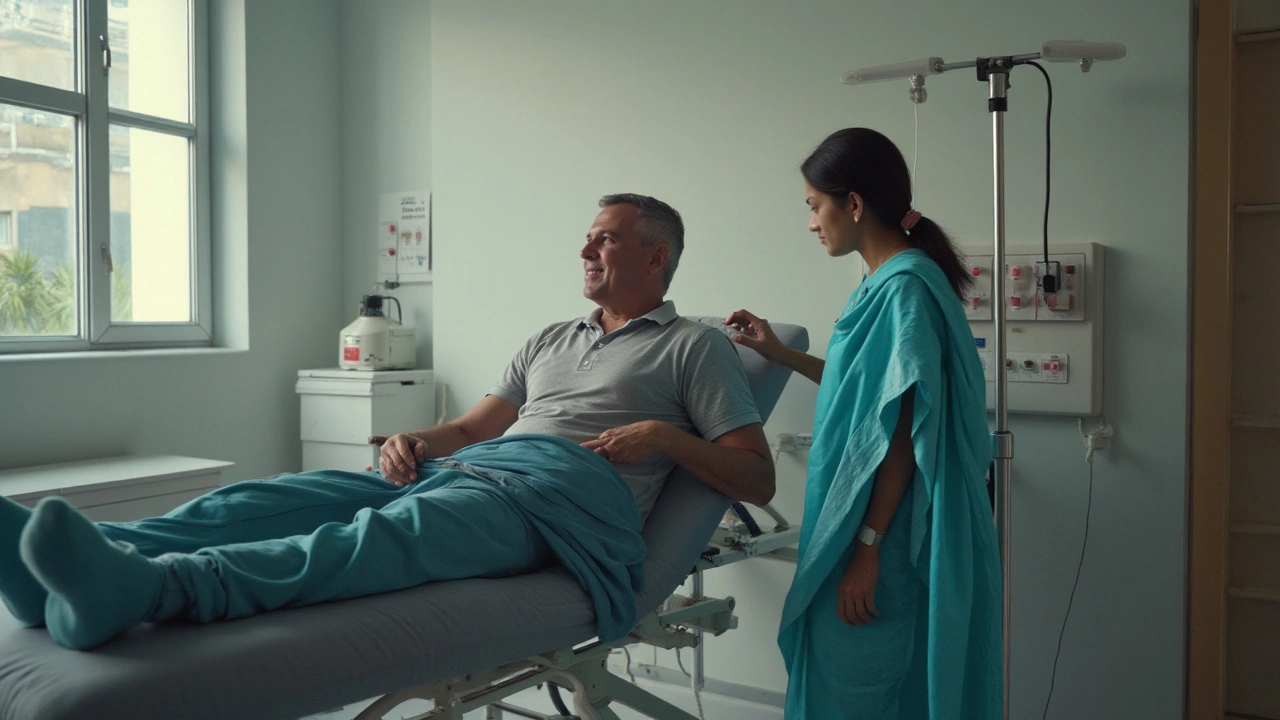-
7

Should You Encourage Knee Movement Post Knee Replacement?
Knee replacement surgery is a life-changing procedure for many, offering the chance to regain mobility and relieve chronic pain. However, the journey to recovery can be just as significant as the surgery itself. One common concern for many patients is the extent to which they should push their new knee to bend. It is a delicate balance that demands careful attention.
After the operation, you might feel anxious about getting back on your feet. You may wonder if encouraging your knee to bend hastens your recovery or if it risks further complications. It's an essential aspect to consider, as mobility plays a crucial role in reclaiming your regular lifestyle.
Let's delve into understanding the nuances of post-surgery knee movement and offer some useful tips on how to ensure a successful and safe recovery path for your precious knees. Remember, every individual's journey is unique, so finding the right pace that works best for you is key.
- Understanding Knee Replacement Surgery
- Importance of Knee Movement After Surgery
- Risks of Forcing Knee Bends
- Tips for Safe Knee Flexibility
- When to Seek Professional Advice
Understanding Knee Replacement Surgery
Knee replacement surgery, often termed as knee arthroplasty, is a medical marvel that has bestowed countless individuals with a renewed lease on life. It involves the removal of damaged bone and cartilage from the thighbone, shinbone, and kneecap, followed by its replacement with artificial components made of metal alloys, high-grade plastics, and polymers. This procedure aims to relieve pain, correct deformity, and most importantly, help patients regain mobility in their everyday lives. Imagine being able to walk pain-free or indulge in your favorite activities, all thanks to the wonders of modern medicine!
The necessity for such a surgery typically arises from the long-term damage caused by conditions such as osteoarthritis, rheumatoid arthritis, or traumatic knee injuries. These conditions gradually erode the protective cartilage in the knee joint, leading to unbearable pain and rigidity. It's remarkable how something like arthritis can strip away both physical capability and mental morale, yet knee replacement offers a viable pathway towards reclaiming independence.
"Knee replacement surgeries have a high success rate, with more than 90% of implants functioning well 10 to 15 years post-surgery," states the American Academy of Orthopaedic Surgeons.
The decision to undergo knee replacement is not taken lightly. It is often the culmination of exhaustive other therapies, including physical therapy and medication aimed to alleviate the symptoms. For many, once these measures do not suffice, surgical intervention becomes the best alternative. Yes, this process may seem daunting, but knowing what's at stake makes it a justified journey. There are numerous hospitals and clinics specializing in this procedure, reflecting its demand and the high level of expertise available globally.
Post-surgery, the path to recovery involves a detailed rehabilitation program. This is crucial for ensuring the success of the implant and is intricately designed to meet the unique demands and the condition of the individual receiving the surgery. The primary aim of this rehabilitation is to restore strength, flexibility, and knee function. Alongside therapy, patients usually learn and understand the nuances of their new knee's expected functionality. Stepping back into everyday life and resuming activities like climbing stairs or light exercises are usually celebrated milestones for any post-surgery patient.
It's interesting to note that this globally performed surgery is constantly evolving with scientific advancements. Today's implants can last several decades with proper care. Specialists are also developing custom-fitted implants made using precise robotic assistance, making the knee replacement procedure even more advanced and promising. Reflecting on these advancements, it's miraculous how technology aligns seamlessly with healthcare to provide people with pain-free, active lives.
| Global Knee Replacement Statistics |
|---|
| Over 600,000 knee replacement surgeries are performed annually in the United States alone. |
| The global knee replacement market accounted for $9 billion in 2020 and is expected to rise significantly. |
Importance of Knee Movement After Surgery
After completing a knee replacement surgery, restoring the knee's flexibility and function becomes a central focus of your recovery process. It's not just about being able to walk again, but about restoring freedom of movement that might have been compromised for years. Getting that knee moving is essential, as it reduces stiffness and swelling, which are common occurrences post-surgery. Lack of movement can cause the formation of scar tissue, which can limit flexibility and lead to a painful recovery experience.
The primary goal after surgery is to prevent the joint from becoming stiff while ensuring the healing process is not disrupted. Gentle and gradual bending is encouraged to help in alleviating discomfort and assisting in the absorption of fluids around the knee area. This can optimally support tissue repair. Surgeons and physiotherapists often recommend specific exercises that facilitate safe knee bending without putting undue stress on the new joint.
There's also the important perspective that strong leg muscles support the new knee joint, aiding your mobility significantly. Regular movement keeps your muscles active and flexible, reducing the risk of falls and further injuries. The initial stages of recovery involve guided exercises prescribed by healthcare professionals, mindful of each patient’s unique recovery trajectory. It's essential to listen to your body's signals and advance through these exercises as recommended.
Exercises to Promote Mobility
Post-surgery exercises usually begin with simple straightening and bending of the knee while lying down. As comfort increases, you might move to chair-assisted knee bends and eventually to standing exercises, which promote weight-bearing and balance. A commonly cited routine involves three to five sessions of gentle stretching and bending routines per day, not lasting more than sixty minutes in total.
"Movement is critical in the recovery process, but it should be controlled and pain should guide limitations," says Dr. Emily Wilson, a well-regarded orthopedic surgeon.
The Bigger Picture: Daily Activities
Incorporating knee movement into day-to-day activities like getting in and out of bed, using the restroom, or even pacing your living area safely can promote recovery. As the knee strengthens, introducing more challenging activities, such as walking short distances or light cycling, becomes part of the regimen. The goal is to integrate these movements naturally into daily life, ensuring they do not feel burdensome or forced.
Ultimately, the key to successful rehabilitation after a knee replacement is not about aggressive movement but about consistent, guided, and thoughtful exercises that emphasize the symbiotic relationship between activity and rest. Maintaining this balance helps your new knee perform optimally, supporting not just your physical well-being but positively impacting your mental health as you gain confidence in your mobility.

Risks of Forcing Knee Bends
After knee replacement surgery, it's natural to crave quick results and return to normalcy. However, forcing your knee to bend beyond its current state can pose significant risks. Understanding these risks is crucial for a safe and effective recovery journey. When you press your knee too hard, you may put unnecessary strain on the joint and surrounding muscles, potentially leading to discomfort or injury. It is essential to listen to your body and not push through pain aggressively, as it can result in complications.
One of the primary concerns associated with overexerting your knee post-surgery is the risk of damaging the prosthetic implant. These components are designed to mimic natural joint movement, yet they have limits. Inappropriately bending the knee can cause undue stress on the implant, affecting its positioning and longevity. This could lead to a need for additional surgical interventions, which is an outcome no patient desires.
Swelling and inflammation are other consequences of excessive knee bending. After surgery, the body is still healing, and the tissues surrounding the knee are delicate. Aggressive movements can lead to irritations or even small tears, increasing swelling and delaying the recovery process. It is vital to balance movement with adequate rest to allow these tissues to heal proficiently.
Susan Wyatt, a reputable physical therapist, says, "Recovery from a knee replacement is a marathon, not a sprint. Gradual, guided exercises under professional supervision ensure long-term success and prevent setbacks."
Another real risk is the development of scar tissue. Overactivity can lead to the creation of excess fibrous tissue around the knee joint, which may restrict movement further. Known as arthrofibrosis, this condition can lead to increased pain and stiffness, potentially necessitating further treatment to break up the scar tissue. Restoring flexibility should be a gradual process, not forced, ensuring tissues have time to adapt.
Lastly, the risk of fractures, albeit rare, exists when undue force and bending occur. The bones surrounding the implant are often weakened post-surgery due to changes in movement and stress distribution. Excessive bending can exert force on these bones, increasing the likelihood of a fracture. Ensuring a slow and steady approach to bending and exercise can prevent these severe complications.
Tips for Safe Knee Flexibility
Once the surgery is behind you, focusing on recovering knee flexibility becomes crucial. The first few weeks set the tone for your rehabilitation. Working towards an increased range of motion, albeit carefully, is vital for success. Start with gentle exercises, as advised by your physical therapist, aiming to gradually improve the knee bend without risking strain. Developing a habit of short but frequent exercise sessions can be more fruitful than long, tiring workouts. Keeping your expectations realistic, listen to your body's signals while progressing towards improved mobility.
Post-surgery, swelling and pain are common barriers to movement. Reducing these symptoms helps in easing the path to a more flexible knee. Regular icing coupled with elevation can counteract the swelling around the knee replacement. Meanwhile, prescribed pain management, which might include medication, allows you to participate fully in exercises without much discomfort. Never hesitate to communicate any changes in pain with your healthcare provider, as this might indicate a misstep in your routine, requiring adjustments.
Adhering to a consistent routine, diligently practicing the recommended exercises, marks the cornerstone of achieving flexibility safely. Consider activities like stationary cycling, which, when feasible, provides a beneficial low-impact aerobic workout aiding flexibility. Importantly, your physician or therapist should tailor your exercise plan to your specific case, ensuring safety is prioritized amidst your effort to regain your knee's full function. Often, patience remains your greatest ally during this process, with gradual progress being a testament to improvement.
An often-cited piece of wisdom from experts is about the importance of a balanced approach. It's not just about pushing the limits; it's about doing so under guidance. As Dr. John Smith of the Orthopedic Institute famously advises, "Your knee is like a new plant; nurture it steadily for it to grow strong."
This mantra underscores the necessity of respecting your journey’s pace, acknowledging that hasty efforts could lead back to setbacks.
With a renewed focus on overall wellness, don't underestimate the contributions of a well-rounded lifestyle. Nutritional diet plans aiding recovery, adequate rest, and hydration form integral parts of enhancing your knee's capability post-surgery. Dealing with a knee replacement is a multi-faceted journey, intertwining physical strength with emotional resilience. As you step forward, carry the assurance that each day of safe practice unfolds new opportunities towards attaining full function, with safety unfailingly at the core.

When to Seek Professional Advice
Understanding when to reach out to a healthcare professional after a knee replacement is crucial for a successful recovery. It's essential to remember that each individual's healing journey is unique, requiring personalized attention. Regular follow-ups with your healthcare team, including surgeons and physical therapists, create a support system that guides you through potential obstacles. If you ever feel uncertain or concerned about your progress, these professionals are the first point of contact you should consider. Persistent swelling, unmanageable pain, or signs of infection like increased redness or warmth around the knee are clear signals warranting immediate attention.
Swelling often accompanies recovery; however, if it persists beyond a few weeks or intensifies despite following recommended protocols, reaching out becomes paramount. The same logic applies to any unusual sensations like instability or a grinding feeling during movement. These could indicate mechanical issues, and addressing them early could prevent further complications. Now and then, someone might find it challenging to achieve the desired range of knee bend; in such cases, professional advice can lead to changes in physical therapy routines.
While mild discomfort is ordinary, unbearable pain isn't. It requires evaluation. Some might feel hesitant to discuss it, fearing it's a common postoperative experience. However, pain is subjective, and the medical team is there to adjust treatments or prescribe additional measures that aid in your comfort.
"Listening to your body is vital; communicate any unexpected issues to your healthcare provider," advises Dr. Lisa Paulsen, an orthopedic specialist.It emphasizes the importance of staying proactive about recovery. They can offer insights and reassurance, helping you stay ahead of potential problems.
Meanwhile, observing the knee for infection (noting changes like unexpected drainage or fevers) is crucial. Identifying these signs early can make a significant difference in treatment efficacy. Always reach out if there's uncertainty about what's considered normal at different stages of healing. Prevention is the best approach, and early intervention often leads to better results. Keeping a log with daily notes about pain levels, knee flexibility, and other symptoms helps communicate effectively with your medical team, providing them with an accurate recovery snapshot.
In some cases, unexpected stiffness or inability to meet recovery milestones might arise. These situations aren't unheard of, and professional guidance can often identify underlying causes and suggest adaptations. Easy-to-overlook aspects like posture adjustments or additional exercises might considerably aid improvement. Look at it as part of the collaborative effort toward a successful recovery that you, your family, and your medical team all contribute to. Such an approach helps track improvement and addresses concerns promptly, securing a smoother and safer rehabilitation process.